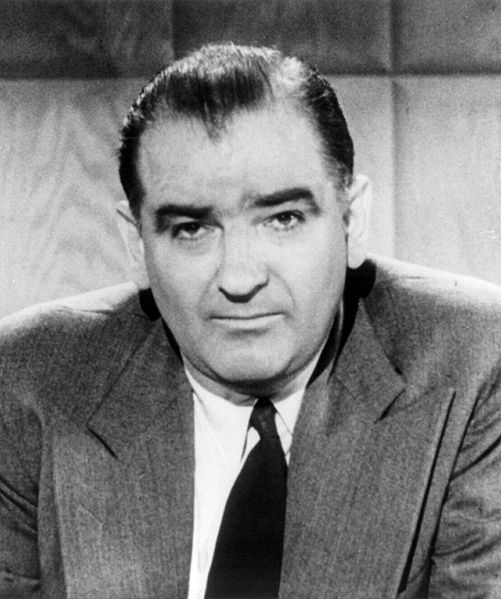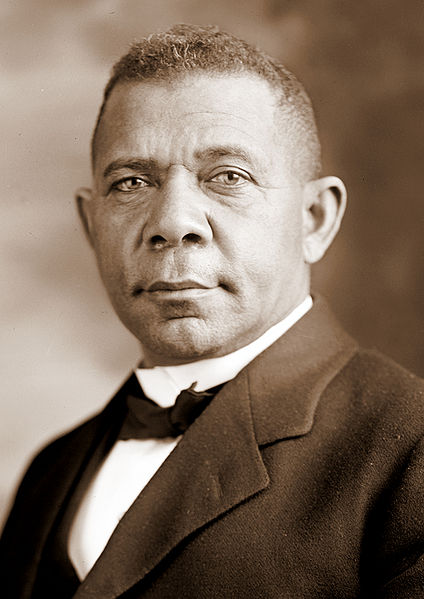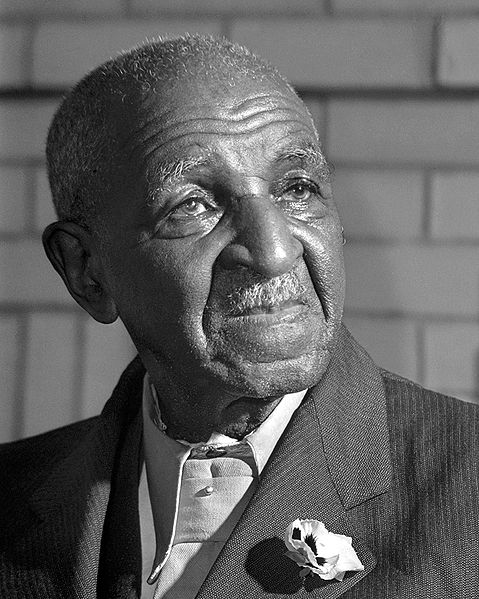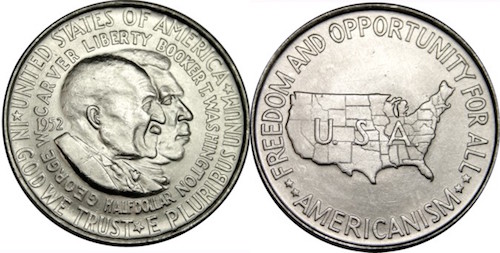
The George Washington Carver/Booker T. Washington Half Dollar: A Cold War Classic
George Washington Carver Half Dollar
The commemorative coin, which features portraits of Booker T. Washington and George Washington Carver (along with too many words) is a true American rah-rah coin. The reverse features the slogan: “Americanism, Freedom and opportunity for all along with a map of the United States. The letters “USA” are superimposed on the map for those not recognizing what our country looks like. One purpose of the coins was to provide funding for memorials for the birthplaces of both Booker T. Washington (in Virginia) and George Washington Carver (in Missouri).
The fight against communism
The original reverse of the coin featured the words: “United against the spread of communism) The secretary of state, Dean Acheson,pooh-poohed the design on fear that it would further irritate the Soviets. Could World War III really start over the design of a commemorative coin? Dr.Planchet thinks not.
The internal communist threat
 Starting in 1950, Wisconsin senator Joe McCarthy, stated that communists had infiltrated the United states. Many of the communists were allegedly part of the Truman administration, but he also went after prominent African Americans such as Paul Robeson and Langston Hughes.
The actor Paul Robeson won the NAACP person of the year award in 1945. Robeson’s politics were seen as pro-soviet, which helped stoke a fear that African Americans in general were pro-soviet. Both Robeson and Hughes were forced to appear before McCarthy’s subcommittee on subversive activities. As a result of the fear that the African American community would become communist sympathisers, one of the stated goals of the commemorative coin was to “oppose the spread of communism among negroes in the interest of national defense.”
Starting in 1950, Wisconsin senator Joe McCarthy, stated that communists had infiltrated the United states. Many of the communists were allegedly part of the Truman administration, but he also went after prominent African Americans such as Paul Robeson and Langston Hughes.
The actor Paul Robeson won the NAACP person of the year award in 1945. Robeson’s politics were seen as pro-soviet, which helped stoke a fear that African Americans in general were pro-soviet. Both Robeson and Hughes were forced to appear before McCarthy’s subcommittee on subversive activities. As a result of the fear that the African American community would become communist sympathisers, one of the stated goals of the commemorative coin was to “oppose the spread of communism among negroes in the interest of national defense.”
Booker T. Washington
Born into slavery, the Southern Republican Booker T. Washington became the model citizen for this anti-communist half. He strongly opposed political agitation and called the questioning of social equality a “folly.” Washington led the Tuskagee Normal and Industrial Institute, which was designed to lead African Americans from poverty by teaching useful skills in farming and industry. He authored several books, including the bestseller, Up from Slavery
, in 1901.
George Washington C arver
arver
Photograph by Arthur Rothstein for U.S. Farm Security Administration
Born around 1864, George Washington Carver was an agriculturalist best known for his inventions on uses for the peanut and sweet potato. Uses of the peanut included cosmetics, dyes, and biofuels. In 1896, Booker T. Washington invited George Washington Carver to join him at the Tuskagee institute, where he taught for 47 years. Carver died in 1943. During World War II, an monument in honor of Carver was proposed arguing that it would “it will further unleash and release the energies of roughly 15,000,000 Negro people in this country for full support of our war effort.”
How the coins were sold
The Washington Carver halves were sold in three coin sets (one from each mint: Philadelphia, Denver, and San Francisco). The mint attempted to sell the sets for $12, but eventually reduced the price down to $6 due to lack of interest. The number of sets each year was quite small: 10,004 in 1951; 8,006 in 1952, 8003 in 1953 and 12,006 in 1954. The Philadelphia mint in 1951 and 1952 and the San Francisco mint in 1953 and 1954, produced many additional coins (over two million in 1952 alone). The government attempted to sell the singles for $5.50 each -- however most remained unsold.

